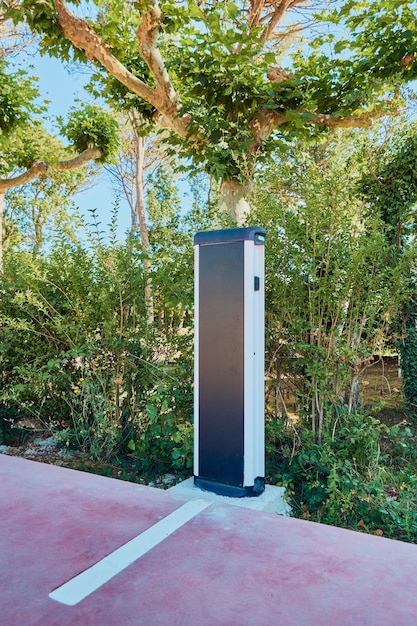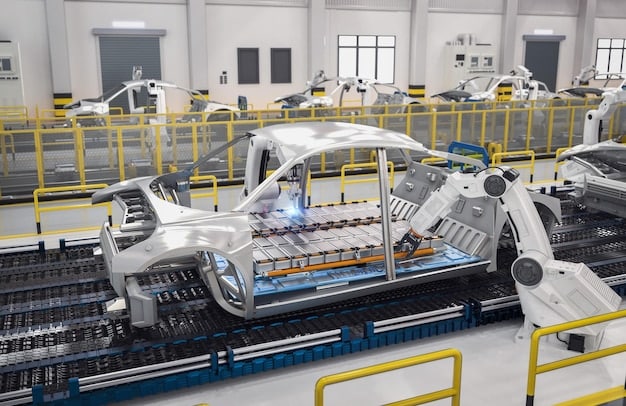$5 Billion Investment: US DOE Boosts EV Charging Network

The U.S. Department of Energy (DOE) is investing $5 billion to expand the nationwide electric vehicle (EV) charging network, aiming to accelerate EV adoption and reduce carbon emissions by making charging more accessible and reliable across the United States.
The **Charging Infrastructure Update: US Department of Energy Announces $5 Billion Investment in Nationwide Electric Vehicle Charging Network**, a transformative initiative poised to reshape the landscape of electric vehicle (EV) infrastructure across the United States. This substantial investment aims to accelerate the adoption of electric vehicles by addressing a critical barrier: the availability of convenient and reliable charging stations.
The Biden-Harris Administration’s Commitment to EV Infrastructure
The Biden-Harris Administration has made a significant commitment to advancing electric vehicle technology and infrastructure. This commitment is reflected in ambitious goals and substantial investments aimed at transforming the transportation sector and reducing carbon emissions.
Executive Orders and Policy Directives
President Biden has issued several executive orders and policy directives aimed at accelerating the adoption of electric vehicles. These include targets for increasing the proportion of electric vehicles in the federal fleet and supporting domestic manufacturing of EV components.
Bipartisan Infrastructure Law
A cornerstone of the administration’s EV strategy is the Bipartisan Infrastructure Law. This legislation allocates significant funding to support the **Charging Infrastructure Update: US Department of Energy Announces $5 Billion Investment in Nationwide Electric Vehicle Charging Network** and related initiatives, providing a crucial financial foundation for the expansion of EV infrastructure.
- National Electric Vehicle Infrastructure (NEVI) Formula Program
- Discretionary Grant Programs for Charging and Fueling Infrastructure
- Investments in Battery Manufacturing and Supply Chains
The Biden-Harris Administration’s commitment to EV infrastructure is evident in its policy directives, legislative achievements, and financial investments. These efforts collectively aim to establish a robust and reliable charging network, fostering the adoption of electric vehicles and contributing to a cleaner, more sustainable transportation system.
Understanding the $5 Billion Investment Plan
The $5 billion investment plan represents a pivotal step towards realizing a comprehensive and accessible EV charging network across the United States. This funding is strategically allocated to address key challenges and opportunities in the EV infrastructure landscape.
Allocation of Funds
The $5 billion is distributed across various programs and initiatives. These allocations include grants to states, municipalities, and private entities to support the installation of new charging stations and the upgrading of existing ones.
Key Priorities
Several key priorities guide the investment strategy. These include: ensuring equitable access to charging infrastructure in underserved communities, promoting interoperability and standardization of charging equipment, and supporting the development of fast-charging technologies.
Impact on Charging Availability
The investment plan is expected to significantly increase the availability of EV charging stations nationwide. By strategically deploying charging infrastructure in key locations, the plan aims to alleviate range anxiety and encourage more drivers to switch to electric vehicles.

The National Electric Vehicle Infrastructure (NEVI) Formula Program
The National Electric Vehicle Infrastructure (NEVI) Formula Program is a central component of the **Charging Infrastructure Update: US Department of Energy Announces $5 Billion Investment in Nationwide Electric Vehicle Charging Network**. It provides dedicated funding to states to build out their EV charging infrastructure.
Funding Structure and Distribution
The NEVI Formula Program allocates funds to states based on a formula that considers factors such as population, vehicle miles traveled, and existing EV charging infrastructure. This ensures that resources are distributed equitably, addressing the unique needs of each state.
Program Requirements and Standards
Participating states must adhere to specific requirements and standards to qualify for NEVI funding. These include ensuring that charging stations are accessible, reliable, and compatible with a wide range of electric vehicles. This promotes a consistent and user-friendly charging experience across the country.
State Implementation Plans
Each state is required to develop an implementation plan outlining its strategy for deploying EV charging infrastructure using NEVI funds. These plans must align with federal guidelines and demonstrate a commitment to expanding EV adoption.
- Strategic Placement of Charging Stations
- Focus on Interstate Corridors
- Collaboration with Local Communities
The National Electric Vehicle Infrastructure (NEVI) Formula Program is a critical mechanism for driving the expansion of EV charging infrastructure. By providing dedicated funding and establishing clear standards, the program supports the development of a cohesive and accessible charging network nationwide.
Discretionary Grant Programs for Charging and Fueling Infrastructure
In addition to the NEVI Formula Program, the **Charging Infrastructure Update: US Department of Energy Announces $5 Billion Investment in Nationwide Electric Vehicle Charging Network** includes discretionary grant programs that offer additional funding opportunities for innovative projects.
Types of Grants Available
These discretionary grants are designed to support a variety of projects, including those focused on advanced charging technologies, community-based charging solutions, and the integration of renewable energy sources with EV charging infrastructure.
Eligibility Criteria
Eligibility for these grants varies depending on the specific program. However, common criteria include demonstrating the potential for significant impact, innovation, and scalability. The grants are open to a wide range of applicants, including businesses, non-profit organizations, and government entities.
Examples of Funded Projects
Examples of projects that could be funded through these grants include the development of ultra-fast charging stations, the deployment of mobile charging solutions in rural areas, and the creation of smart charging systems that optimize energy usage.
The discretionary grant programs provide valuable opportunities for supporting innovative and impactful EV charging projects. By targeting specific challenges and fostering collaboration, these grants contribute to the development of a more advanced and sustainable EV ecosystem.
Impact on Electric Vehicle Adoption and the Economy
The **Charging Infrastructure Update: US Department of Energy Announces $5 Billion Investment in Nationwide Electric Vehicle Charging Network** is expected to have a wide-ranging impact on electric vehicle adoption and the economy.
Increased Consumer Confidence
By expanding the availability of charging stations, the investment plan will increase consumer confidence in electric vehicles. Addressing range anxiety and making charging more convenient will encourage more drivers to consider switching to EVs.
Job Creation and Economic Growth
The development and deployment of EV charging infrastructure will create new jobs in manufacturing, installation, and maintenance. This will stimulate economic growth and support the transition to a clean energy economy.
Environmental Benefits
The increased adoption of electric vehicles will reduce carbon emissions and improve air quality. This will contribute to mitigating climate change and creating healthier communities.

Challenges and Opportunities Ahead
While the **Charging Infrastructure Update: US Department of Energy Announces $5 Billion Investment in Nationwide Electric Vehicle Charging Network** represents a significant step forward, there are challenges and opportunities that need to be addressed to ensure its success.
Supply Chain Constraints
Supply chain constraints could impact the availability of charging equipment and components. Addressing these challenges will require diversifying supply sources and investing in domestic manufacturing capacity.
Grid Modernization
Supporting the increased demand for electricity from EV charging will require modernizing the electric grid. This includes upgrading transmission infrastructure and integrating renewable energy sources.
Workforce Development
Building and maintaining the EV charging network will require a skilled workforce. Investing in training and education programs will be essential to ensure that there are enough qualified workers to meet the growing demand.
- Strategic Partnerships
- Technological Innovation
- Community Engagement
Addressing these challenges and capitalizing on these opportunities will require collaboration across government, industry, and communities. By working together, stakeholders can ensure that the **Charging Infrastructure Update: US Department of Energy Announces $5 Billion Investment in Nationwide Electric Vehicle Charging Network** delivers its full potential, driving the adoption of electric vehicles and creating a more sustainable future.
| Key Point | Brief Description |
|---|---|
| 💰 Funding Amount | $5 billion investment in EV charging infrastructure. |
| 🎯 Key Objective | Expand and improve the nationwide EV charging network. |
| ⚡ NEVI Program | Funds allocated to states based on a formula. |
| 🌱 Environmental Impact | Reduced carbon emissions and improved air quality. |
FAQ
▼
The primary goal is to expand and enhance the nationwide electric vehicle charging network. This aims to make EV charging more accessible and reliable for drivers across the United States.
▼
The NEVI Formula Program allocates funds to states based on factors like population, vehicle miles traveled, and the existing EV charging infrastructure within each state.
▼
The investment is expected to create jobs in manufacturing, installation, and maintenance. Additionally, It should stimulate economic growth and support a transition to clean energy sources.
▼
By increasing the availability and reliability of charging stations, the investment aims to boost consumer confidence. This encourages more drivers to consider switching to electric vehicles.
▼
Several challenges must be addressed, including supply chain constraints, grid modernization, and workforce development. Overcoming these obstacles is crucial for the success of the initiative.
Conclusion
The **Charging Infrastructure Update: US Department of Energy Announces $5 Billion Investment in Nationwide Electric Vehicle Charging Network** marks a pivotal moment in the transition to electric mobility in the United States. By addressing key barriers to EV adoption and fostering innovation, this initiative promises to accelerate the shift towards a cleaner, more sustainable transportation future, and it will foster economic prosperity.





